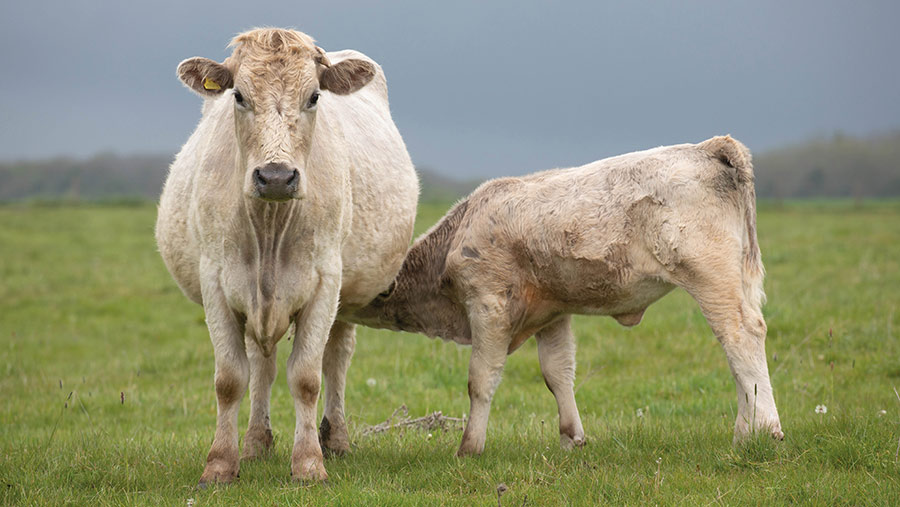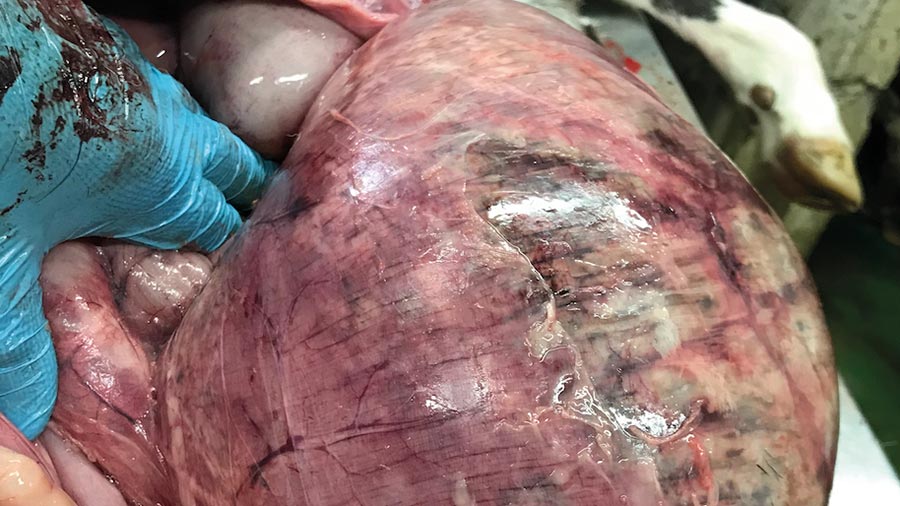Creep feeding suckler calves: The risks and how to do it right
 © Tim Scrivener
© Tim Scrivener Every year calves die because of access to creep. Ben Strugnell, who runs the Farm Post Mortems service explains why this happens and how to avoid these losses
It is important to remember that a calf starts out life as a monogastric (like a chicken) when it is sustained on milk, and quickly becomes a ruminant (like adult cows and sheep).
Initially, milk goes straight into the abomasum (the fourth chamber of the stomach), which is an acidic environment, like the human stomach.
As the calf develops it eats increasing amounts of forage and starch. Starch is energy for growing the rumen wall. Meanwhile, the calf continues taking milk into the abomasum.
See also: Advice on weaning and creep feeding suckled calves
Why rumen stability is important
The rumen wants stability, so the same chemical processes can occur that use the same microbial populations at a similar pH level.
Food is broken down by the rumen bugs and turned into volatile fatty acids (VFAs) such as propionate, butyrate and acetate.
Unlike straw or old, lignified grass, starch – readily available in creep – and sugar – readily available in young grass – are both broken down easily and quickly. This means digestion is fast, and therefore acid production happens quickly, sometimes too quickly, and rumen pH drops.
Starch is rapidly fermented and causes lactic and propionic acid to be produced. When starch intake is excessive or prolonged, this acidity can suppress the bacteria which digest cellulose (acetate), meaning the rumen struggles to break down forage.
There are several challenges to rumen stability for a suckler calf:
Grass
- Grass grows unevenly (moisture, temperature, species/variety, day length, season)
- Sugar levels in grass may be much higher in warm weather, when it is growing fast
- The ratio of stem (low in sugar) to leaf (higher in sugar) will change as the season advances
- Excess sugar is a risk for bloat because it can cause a sudden imbalance in the rumen and stop it working
- Sugars are immediately dissolved in the rumen and need a good source of nitrogen rather than protein to help utilise them
- Almost all carbohydrate in grass is in the form of sugars, not starch
Creep
- Creep intakes can be variable and unpredictable
- Risk can be weather dependent – calves might choose to graze grass in average weather and stand in the creep feeder on a rainy day
- Some starch is digested in the rumen and some in the hindgut and can cause issues in both places.
How rumen instability kills calves
The rumen can cope with some variability, but risk increases when calves decide to eat a large slug of starch from the creep feeder, or when grass sugar levels are higher. This creates bloat. There are three main ways calves die from this:
1 Acidosis
What it is
Acidosis is a rapid and sustained drop in the rumen pH from its typical range of around pH 6.5. This can happen when a large amount of creep is eaten after a few days of abstinence.
The starch is rapidly fermented by rumen bacteria to make lactic acid, which lowers pH. A pH of less than 5.5 is often said to be acidotic.
The rumen stops turning over and functioning. At pH 4-4.5 the animal can die. The speed of change is probably more important than the pH itself.
Why it happens
The rumen has a design flaw that means it cannot expel gases when the rumen stops turning over. Breathing therefore becomes difficult as gas accumulates in the rumen.
The extended rumen exerts pressure on the lungs and in some cases blood cannot return to the heart from the hindquarters. If that doesn’t prove fatal then sometimes the whole animal can be acidic, and this can also be fatal.
2 Abomasal bloat
What it is
Certain bacteria (clostridia, sarcina) in the abomasum are believed to like a starchy environment.
These bacteria produce toxins which can damage the stomach wall, leading to septicaemia or complete perforation. Stomach contents can then spill into the abdomen, known as peritonitis, which is usually followed by death.
Why it happens
This is more likely when there is starch left over in the rumen which hasn’t been digested by the rumen bugs, probably because there is too much of it.
It’s not enough to cause ruminal bloat, but enough to provoke the abomasal bacteria into proliferation.
3 Intestinal torsion
What it is
This is where the offending starch flows through the rumen and abomasum without causing major issues and arrives in the small intestine where it meets larger bacterial populations as its heads towards the colon, suddenly producing large amounts of gas, leading to torsion and twisting, causing the gut to lose blood supply.
Why it happens
Twisting and torsions can lead to damage to the intestinal wall, which means the bacteria can enter the blood, causing death.
The risk of this problem occurring can be reduced if the rumen takes more starch, which is why it’s important for the rumen papillae to develop from an early age.

Damage to the lining of the abomasum caused by bacterial growth, triggered by starch. © Farm Post Mortems
Economic consideration
Even with creep at £260/t (26p/kg), the cost of paying £1.56-£2.08 to gain one kilo (at an average of 6-8kg of feed: 1kg of liveweight gain) looks to pay off, particularly if the calf is worth 250-300p/kg or more.
But if you kill a calf that would have been worth £900 with creep, the calculations look different. It’s therefore worth asking why you need creep in the first place:
- Could you rotate mobs or subdivide grassland to maintain pasture quality?
- Genetics – are dams milky enough, are bulls providing good growth genetics?
- Is creep a short-term fix for other issues?
Advice on buying and feeding creep
If grass growth and cow condition are adequate, creep should be restricted, or it’s just a cost.
Creep is justifiable when grass is short, cows are struggling to milk and heifers need support for development, to alleviate pressure and keep calves growing.
Later, it’s useful to reduce stress by introducing it four-to-six weeks before weaning or housing.
What to look for in creep
- Feed should be balanced appropriately to support rumen development, growth, palatability, and rumen health. It should be balanced for minerals and consistent – inspect every load.
- Starch sources such as wheat or barley are key for stimulating the development of the rumen papillae to allow future absorption of volatile fatty acids from forage digestion.
- Good-quality and digestible protein sources such as soya, rape, and distillers’ grains are important to encourage rumen function and frame growth. Watch out for sunflower meal and gluten if they feature near the beginning of the ingredients on the ticket as these are less digestible.
- Some digestible fibre sources such as sugar beet help palatability and supply an energy source that does not have such a negative effect on rumen pH.
- Aim for a starch and sugar level of about 30%. If much lower, rumen papillae development may be delayed; if much higher, unless alkanised feed sources can be included, acidosis might be more likely.
- Aim for a crude protein level of 14-16%, depending on the farm situation.
- Take care with feeds that are high in wheatfeed as these may be lower in energy.
Feeding creep
- Introduce calves to creep slowly, building up to no more than 1-1.5kg a head a day and don’t introduce it when they are hungry, that is, when cows are drying up or pasture growth slows.
- Check feed levels regularly to stop creep running out. It’s best to allow calves to eat little and often.
- Consider using specialised feeders to control intakes as required, or a buffer such as alkaline treated grains (if more than five-to-six months of age) or limestone flour.
- Check feeders to gauge intakes.
- Weigh calves when the cattle are being worked is a chance to see if growth rates are what you expect.
(Source: Debby Brown, Dugdale Nutrition)
